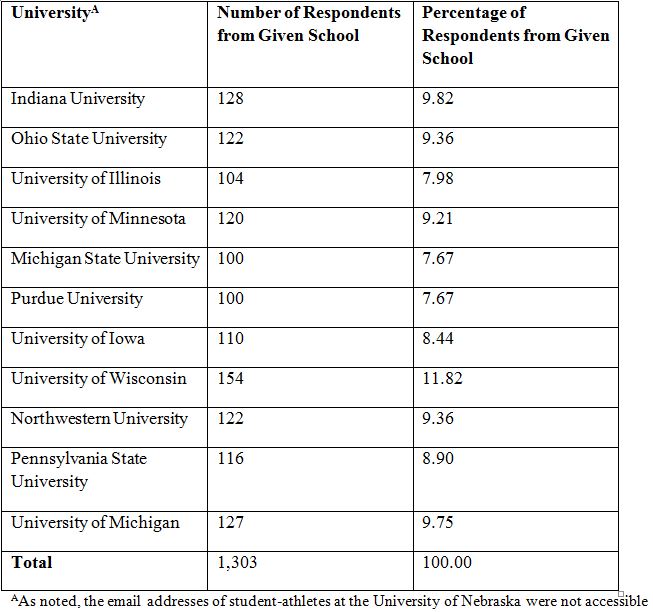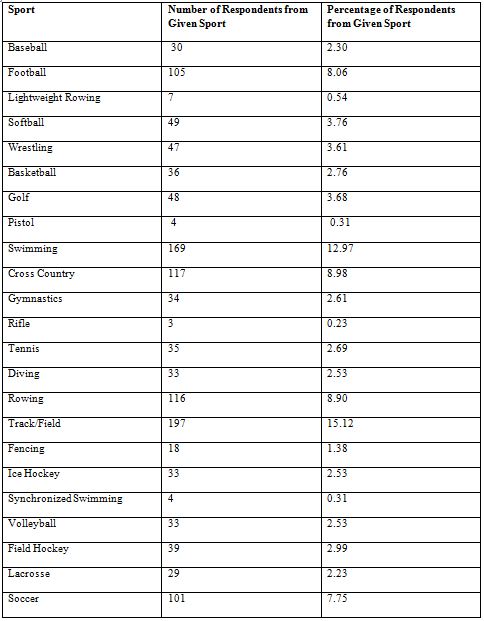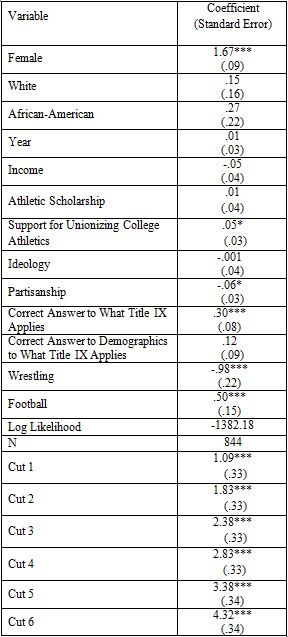Submitted by James N. Druckman, Northwestern University; Mauro Gilli, Northwestern University; Samara Klar, University of Arizona; Joshua Robison, Northwestern University.
Abstract:
Purpose: Few policies have been deemed as successful as Title IX, which, in theory, ensures equal educational opportunities for women. While the language of the law makes no mention of athletics, Title IX has nonetheless become a cornerstone of equality in athletics and the basis of expansion of sports programs for female athletes. As with any public policy, however, there is much debate about the ramifications, potential, and implementation of Title IX. Additionally, change and interpretation can be traced back, to a large extent, to public support or opposition. Yet, virtually no work explores public opinion about Title IX, particularly among the very issue public most affected by the law: college athletes.
Methods: A wide-scale survey of opinion and knowledge of Title IX among college athletes.
Results: The key correlates explaining support for Title IX are identified. A key finding is that nearly half of college respondents do not fully grasp the breadth of Title IX, which potentially limits the impact of the law.
Conclusions: Much educational efforts are needed concerning Title IX.
Application in Sport: The results show what characteristics shape support for Title IX, thereby providing guidance to individuals interested in promoting (or arguing against) the law. Perhaps most importantly, many affected student-athletes do not fully understand Title IX and thus educational efforts continue to be needed.
Athlete Support for Title IX
Introduction
Public policy refers to the actions or inactions taken by the government with regard to an issue (e.g., laws, regulations, funding). Scholars explore public policies from a variety of perspectives ranging from the ways in which mass preferences impact policies to investigating how policies affect citizens, or both (18). The term policy feedback describes this process and refers to situations in which some types of political mobilization lead to the implementation of a new policy, resulting in subsequent social or political change, and potentially in the stimulation of further mobilization (15). The development of public policy is thus intimately intertwined with public opinion.
Title IX is one of the most noted and often celebrated public policies resulting in massive social change. The law, which was enacted in June of 1972, states that, “No person shall, on the basis of sex, be excluded from participation in, denied benefits of, or be subjected to discrimination under any educational program or activity receiving Federal financial assistance.” The goal of Title IX is to ensure that women have equal access to education funding. The initial implications of the law for athletics were unclear given that athletics was not formally mentioned in the Act. This ambiguity can be seen in a letter from University of Michigan football coach Bo Schembechler to President Ford in 1975 in which Schembechler asks the President for clarification concerning the implications of the law for athletics. However, the impact of Title IX on athletics is no longer ambiguous. In high school athletics, for example, just 7.4% of athletes prior to the passage of Title IX were women; by 2011, the percentage of females among high school athletes reached 41.4% (13). Indeed, Title IX is widely celebrated for influencing this trend– such that the Act graced the cover of Sports Illustrated on the Act’s 40th Anniversary with a story that began, “Title IX’s impact has reached well beyond the playing field, forever changing the role of women in society” (20).
While there is no doubt that Title IX has successfully broadened participation in athletics by women, gender disparities persist. Women remain under-represented in participation in sports, e.g., by about 10% (13), and sports played by female athletes are often treated as secondary to sports played by men, in terms of coverage and resources (7, 11). Moreover, a non-trivial number of individuals continue to oppose Title IX because many schools have chosen to eliminate programs for male athletes, rather than add programs for female athletes, in order to achieve compliance. As California Assemblyman Chris Norby stated in 2012, “We need to be honest about the effects of what I believe are the faulty court interpretations of federal enforcement of Title IX because it has led to abolition of many male sports across the board” (9). A particularly publicized loss to male athletics is wrestling. The New York Times reported in 2003 that, due to Title IX regulations, the number of male wrestling teams had fallen from 363 in 1982 to just 229 in 2001, while the total number of institutions in the NCAA had grown from 787 to 1049 during that same time period (12). Finally,enforcement of Title IX is, by nearly all accounts, far from successful. For example, the penalty for violating Title IX is the withdrawal of federal funds but, according to the Women’s Sports Foundation, “Despite the fact that most estimates are that 80 to 90 percent of all educational institutions are not in compliance with Title IX as it applies to athletics, such withdrawal of federal moneys has never been initiated” (24).
To consider the future of Title IX, there is perhaps no better place to start than with public opinion and, in particular, with the very issue public most likely to mobilize to ensure change (see 14 for more discussion of “issue publics,” which are those individuals most affected by an issue and most likely to see the issue as important). This is captured in the aforementioned policy feedback model (21) that emphasizes how policy “effects depend ultimately on how public policies fit into the lives of individuals…” (15).
The issue public for Title IX concerns mostly college (but also high school) athletes and particularly female athletes. Whether an issue public can effectively mobilize to expand or alter the policy in question is ultimately determined by the following considerations. Do issue public members have similar opinions on whether to expand or alter the policy in question in a particular manner? For instance, if female athletes are starkly divided as to whether the policy should be expanded, then this would presumably limit the ability of these students to organize for that end. Moreover, affected athletes need to understand the policy so that potential violations and novel mobilization possibilities can be identified. These mobilization efforts may entail individual actions such as lawsuits or, on a larger scale, a collective social movement that then must deal with the difficulty of collective action mobilization (16). As far as the authors know, scant work has addressed whether student-athletes meet these criteria. The focus of this paper is on public support and understanding – leaving the question of action (individual or collective) for future work, as that issue cannot be addressed without first exploring public thinking. In essence, this approach follows the strong statement by Disch (6) that political representation works by “paying attention to the question of whether affected parties recognize themselves as such and, so, mobilize to demand a response.”
Introduction to Title IX
A number of excellent books detail the history of Title IX. This account will not repeat these stellar reviews (3) other than to note two aspects. First, as mentioned, Title IX covers all educational activities including access to curricula, health care, clubs, and so forth. Second, the implementation of the law has proven extremely complex, generating much legal discussion, (1). Concerning athletics, a common, albeit not universal and sometimes controversial, strategy has been to employ a three-pronged approach such that a school must: (a) provide athletic participation opportunities that are substantially proportionate to the student enrollment, OR (b) demonstrate a continual expansion of athletic opportunities for the underrepresented sex, OR (c) fully and effectively accommodate the interest and ability of the underrepresented sex.
A school found to violate Title IX could in theory lose federal funding and students or parents could sue for violations. However, while some lawsuits have been successful, ultimately no school has lost federal funding. Other than individual settlements, the typical cost to a university for non-compliance is delayed federal funding and legal fees for cases brought to court (8). In short, this article seeks to understand whether student-athletes understand the law and whether athletes also support the law, as these are necessary components of action.
Surprisingly, there exists virtually no work on public opinion toward Title IX in general, much less on opinion among the key issue public (the students). The main existing scholarly work on public opinion about Title IX comes from those who explore public opinion about gender equality more generally (17). This work finds fairly broad support for equal funding but there exists some fluctuation across surveys depending on question wording. Notably, individuals with more education or income sometimes support greater equality in funding and, perhaps not surprisingly, women are more supportive than men although not always to a large degree.
The authors of this study conducted an expansive search using the Roper Center iPOLL archive and found that, among the few questions regarding support for Title IX, only five did not explicitly explain to respondents what the law does. These five polls ask about overall approval of the law but none offer detailed analysis of who supports Title IX and thus existing work does not explain support, much less knowledge, concerning Title IX. General findings are mixed and depend on whether the possibility of cutting male athletic programs is stated. When not mentioned, substantially more than 50% support the law, with women and liberals substantially more supportive than men and conservatives respectively. One notable finding is a March 2011 New York Times poll showing that a full 47% of respondents indicated having heard nothing at all about Title IX. This begs the question: even if many in the general public have not heard of Title IX, is there wide awareness among those who are directly affected? Unfortunately, none of these surveysfocus on those most affected by the law: student-athletes.
Methods
The survey used here is novel in that the survey focuses on a class of issue publics: college student-athletes. The survey focuses on both female athletes who may not have otherwise had athletic opportunities and male athletes who may face athletic cuts. As explained, the attitudes and understanding of these individuals are important for moving forward in terms of possible feedback (12).
In particular, this current survey focuses on athletes in the National Collegiate Athletic Association (NCAA) Big Ten conference. This is an ideal starting place since this conference includes a large amount of variance among Universities (e.g., in terms of such factors as size, demographics, and national media coverage). The Big Ten conference is located primarily in the Midwest and at the time of the survey included twelve major universities – with the University of Nebraska as the western-most point and Penn State as the eastern anchor of the conference. After the completion of this survey, the Big Ten announced that Rutgers and the University of Maryland would be joining the conference in 2014. Every university in this conference has an athletic program that competes in Division I NCAA athletics.
In the spring of 2012, the authors accessed the athletic websites of all twelve Big Ten schools and obtained the full rosters for every sport at every school. The authors then accessed the website for each school to find the email address of every student-athlete listed on those rosters, thus creating the only current directory of Big Ten student-athletes known to the authors. This information was publicly available at all schools except for the University of Nebraska. Officials at the University of Nebraska were contacted in order to obtain directory information but the university declined access and thus athletes from the University of Nebraska are excluded from the sample. In addition, months before the survey, the authors wrote to the Big Ten commissioner to alert the official of the survey, asking for any input, but did not receive a response.
In the end, the authors located 6,375 names on rosters. No e-mails were found for 479 student-athletes (who, presumably, were no longer enrolled). Of the 5,896 emails sent out, 1,803 bounced back, likely because these students had left the school or, alternatively, had mis-listed emails. Thus, a total of 4,093 e-mails were successfully sent out and, to the best of the authors’ knowledge, reached the intended targets. Reminder emails were also sent out to all respondents. Sample size varied across schools for a variety of reasons. First, schools have different numbers of sports and thus some schools simply have significantly more student-athletes. Second, the survey took place during early spring of 2012 and thus some of the schools were near the end of the term which may have made responding more or less likely. Of more relevance is that some sports may have been affected if in season or in the playoffs and thus these student-athletes may have had less time to respond. Third, based upon the volume of “returned e-mails,” schools appear to vary in how frequently email lists are updated; that is, some schools had out-of-date e-mail addresses listed for students who were no longer enrolled but had previously been on a roster. This possibility was formally tested by selecting a few schools and resending about 50 emails to each; the amount of emails that bounced back varied across schools. In terms of response rate, 1,303 responses were received leading to a rate of 1303/4093 = 31.8% (of course the number of respondents, N, varies in the analyses because not all respondents answered all questions). This response rate exceeds typical response rates in email surveys and especially those that are conducted without incentives (see 5, 20, 22). In short, this survey outperforms the current norm in terms of both response rate and, as detailed below, respondent heterogeneity.
This sample is neither a census of the Big Ten nor perfectly representative of the division. However, this sample provides a telling view of opinion and knowledge regarding Title among student-athletes in a major and diverse conference. Moreover, this is the first survey of this kind and, as mentioned, this survey provides stark and compelling data that should serve as a blueprint for future work.
Note:Athletes who played multiple sports were allowed to enter a second sport played. A total of 166 respondents played a second sport. The focus here is strictly on the first choice. Co-ed sports were also merged for simplicity but a break down by gender X sport is available from the authors.
Table 3. Respondent Demographics
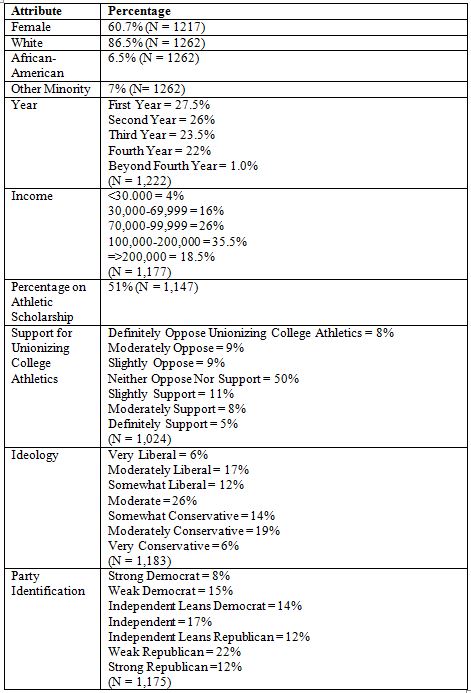
Sample sizes and response rates for each University are provided in Table 1. The table shows that each University provided similar response rates and thus the results are not particularly driven by a single school, or even by a few select schools. Table 2 shows the sample size and response rate by sport. Variance exists here simply because some sports have many more student-athletes and several schools do not support each of the sports. As mentioned above, there is some variance in response rate that may relate to whether the sports are in-season or not, and because sports may vary in terms of off-season practice schedules. However, this is an issue in need of further exploration that is beyond the scope of the current study. Most important, perhaps, is Table 3, which provides the demographic breakdown of the sample. The main point is that the survey is fairly representative. The higher response by females is typical of college surveys and reflects the reality that there are more females enrolled in universities than males (9). The additional demographics largely reflect the reality of Big Ten student-athletes when compared to reported features of schools. Perhaps most interesting is the heterogeneity in partisan and ideological identity, which stands in contrast to the stereotype of the liberal college student. Note that respondents had the choice to not respond to a particular question and thus the sample size varies across different questions as a result.
Results and Discussion
The first question of interest was whether the respondent had heard of Title IX; all exact question wordings are available from the authors. Nearly 84% (944) of respondents claimed to have heard of Title IX, while 12% (137) reportedly had not and 4% (49) were not sure. Perhaps of much greater interest are the two questions that follow. The first asked “Do you know if Title IX applies to college spending on athletics, on education, on both, or on neither?” and the second asked “Do you know if Title IX applies to gender, race, both, or neither?” The results for each question appear in Table 4.
Table 4. The Application of Title IX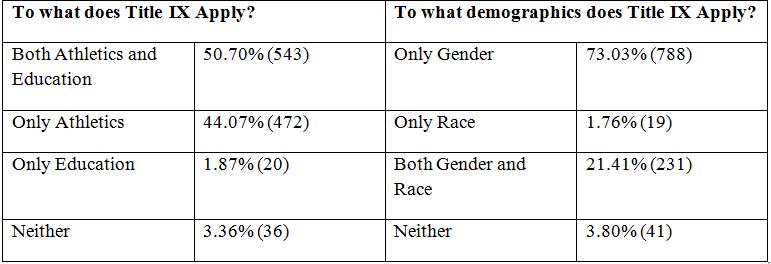
The starkest finding is the evident lack of knowledge among athletes about the content and target of Title IX – a law that directly impacts student-athletes. Despite no explicit mention of athletics in the Act, 44% of athletes believe Title IX regulations apply only to athletics and not also to education. Notably, there is no evidence this relates to political knowledge more generally; for example, the survey included a measure of political interest and the results suggest that interest is equally distributed among those who answered the question correctly or not. Approximately half of all respondents recognized Title IX covers both athletics and education. This could be seen as a concerning finding because constituencies targeted by the Act (e.g., women athletes, of whom – like men – only 50% had the correct answers) fail to see the protections offered by the Act on a host of educational issues including sexual harassment, sexual graffiti and language, handling of rape cases, use of standardized testing such as the National Merit Examination (where “even the test-makers own research admits that the test under-predicts the performance of females and over-predicts the performance of males” see note for source of quote), and protections of pregnant students (25). In terms of the second question, significant majorities (73%) correctly recognize that Title IX applies only to gender, but over one fifth (21.4%) or respondents believe Title IX also applies to race, suggesting that knowledge is nowhere near complete on what Title IX can and cannot do.
An additional focus of this survey is support among student-athletes for Title IX. Respondents were asked, “Given your own knowledge about Title IX, do you disagree or agree with its main tenets?” on a 7-point fully labeled scale ranging from definitely disagree (1) to definitely agree (7). The mean response among is 4.35 (std. dev. = 1.90; n = 1,080). To understand who supports the Act, responses were analyzed using an ordered probit model to regress the support score on the main demographics listed in Table 3 (with “other minority” ethnicity as the excluded group), along with four other relevant variables. These include the two variables listed in Table 4 coded as whether the respondent had a correct or incorrect understanding of the application and knowledge of Title IX, since greater knowledge may increase support. Dummy variables for two sports were also included: wrestling and football. The wrestling variable was included because, as explained, this is the most often targeted sport cut for men when schools eliminate male teams to comply with Title IX. The football variable was included because football is the only sport with no female counterpart (i.e. only males are eligible to play). Since softball is an analogous option to baseball, there is no reason to expect the dynamics observed in football also in the case of baseball (as indicated by the recent joining of the national federations of baseball national federations for an Olympic bid).
***p£.01; **p£.05; *p£.10 for two-tailed tests. Entries are ordered probit coefficients with standard errors in parentheses.
Results are reported in Table 5 using conservative two-tailed tests since no definitive predicts were advanced other than for gender. The central dependent variable explored here is support for Title IX, as knowledge about Title IX (i.e., to whom the Act applies and for what the Act applies) logically comes prior to whether or not one supports the Act. With these analyses, the authors explored correlates of knowledge and found that, in terms of knowledge of whether Title IX applies to education and athletics, there are no significant determinants aside from income, which has only a marginally negative relationship (that is, higher income is weakly correlated with lower knowledge of Title IX). The investigation focused also on correct answers to whether Title IX applies only to gender or also to other categories (or none). The results suggest that, perhaps surprisingly, women were more likely to be incorrect. This complete set of analyses is available from the authors.
The most striking result presented in Table 5 concerns gender, which has a large and significant effect of women showing much greater support for Title IX, as compared with men. Using the Clarify statistical program, and setting all other predictor variables to mean values, the probability that a woman would support Title IX (meaning a support score of 5, 6, or 7) is 76%, whereas the analogous probability for a male is dramatically reduced, at only 26% (when merged, the overall probability is 51%). Perhaps the second most notable variable is knowledge that Title IX applies to both education and athletics. Someone with that knowledge, all else constant, has a 56% chance of supporting Title IX, whereas someone lacking the knowledge has a 45% likelihood of support.
Politics also matter. Republicans are less supportive of the Act and those more supportive of unionizing college athletes are more supportive of Title IX. This is not surprising given that Republicans tend, generally speaking, to be more averse to additional regulations or government complexity. Thus, Title IX, even in the public opinion domain, is a partisan issue. Finally, not surprisingly given the above discussion, wrestlers strongly oppose Title IX. This is not true for football players who, in fact, substantially support Title IX, perhaps because these athletes have little reason to see the law as threatening the sport they play, which is one of the few that often generate revenue.
Conclusions
While a broader sample would be an obvious next step, the findings presented in this study have important implications for future efforts aimed at both legal and social change (i.e., policy feedback) regarding this contemporary legislation. What is often hailed as one of the most successful public policies in the last half century is, in many respects, poorly understood by the exact constituents who have the most at stake. This lack of understanding is likely caused by poor athletic compliance with the Act as well as other possible educational inequalities unexplored here. Regardless, an important result of this study is that a key issue public – female athletes – is significantly more supportive of Title IX, which provides a baseline for some movement and feedback. These results suggest that this key group is most susceptible to mobilization attempts – if policy change is seen as a desirable necessity. The goal of this study was not to advance an argument in support or opposition of Title IX, but rather to illustrate that one of the most important public policies in recent times continues to be misconstrued and broadly understudied, even by those who are most affected by the law. This has critical implications for the implementation of this legislation, for future policies, and for the assurance of equal access in education (a fundamental element of democracy) (15). This study lays the ground work to move from excellent critical histories and anecdotes to being to incorporate survey methodology and opinion data as methods for policy evaluation and action (whether individual or collective). Given that Title IX is a political issue, as seen from the role of partisanship and union support, steps forward are bound to be colored by politics. This study provides the first evidence concerning the preferences among college-athletes with regards to Title IX.
Applications In Sport
These findings have important and straightforward public policy implications. The results demonstrate which characteristics shape support for Title IX, thereby providing guidance to individuals interested in promoting (or arguing against) the law. Perhaps most importantly, many college student-athletes clearly do not fully understand Title IX and thus educational efforts continue to be needed.
Acknowledgment: The authors thank the many students who helped identify contact information for the survey respondents.
References
- Anderson, P.M. (2013). Gender equity forty years later. The International Sports Law Journal, 13, 3-8.
- Boyce, R. (2008). Cheerleading in the context of Title IX and gendering in sport. The Sport Journal, 11, 1-1
- Brake, D.L. (2010). Getting in the game. New York: New York University Press.
- Carter, S.D. (2011). How to comply with the Department of Education’s Title IX sexual violence guidance. Campus Safety Magazine. Retrieved from: http://www.campussafetymagazine.com/channel/university-security/articles/2011/04/how-to-comply-with-the-dept-of-ed-s-title-ix-s-sexual-violence-guidance.aspx
- Couper, M.P. (2008). Designing effective web surveys. New York: Cambridge University Press.
- Disch, L. (2012). Democratic representation and the constituency paradox. Perspectives on Politics, 12, 599-616.
- Eastman, S.T., & Billings, A.C. (2001). Biased voices of sports. The Howard Journal of Communications, 12, 183-201.
- Feminist Majority Foundation. (n.d.). Education Equality: Winning Title IX Cases. Retrieved from: http://www.feminist.org/education/consequences.asp
- Fox Sports. (2012, May 15). Chastain bristles at Title IX attack. Retrieved from http://msn.foxsports.com/foxsoccer/usa/story/brandi-chastain-uswnt-bristles-at-chris-norby-comments-title-IX-051512.
- Franke, R., S. Ruiz, J. Sharkness, L. DeAngelo, & J. Pryor. (2010). Findings from the 2009 administration of the college senior survey (CSS). Retrieved from: http://www.heri.ucla.edu/PDFs/pubs/Reports/2009_CSS_Report.pdf.
- Higgs, C.T., Weiller K.H., & Martin, S.B. (2003). Gender bias in the 1996 Olympic games. Journal of Sport & Social Issues, 27, 52-64.
- Irving, J. (2003, January 28). Wrestling with Title IX. New York Times. Retrieved from http://www.nytimes.com/2003/01/28/opinion/wrestling-with-title-ix.html?pagewanted=all&src=pm.
- Keilman, J. (2012, May 31). Title IX’s gains stall in sports. Chicago Tribune, 1, 6.
- Krosnick, J.A. (1990). Government policy and citizen passion. Political Behavior, 12, 59-92.
- Mettler, S., & Soss, J. (2004). The consequences of public policy for democratic citizenship. Perspectives on Politics, 2, 55-73.
- Olson, M. (1965). The logic of collective action. Cambridge: Harvard University Press
- Sigelman, L., & Wilcox, C. (2001). Public support for gender equality in athletics programs. Women & Politics, 22, 85-96.
- Soroka, S.N., & Wlezien, C. (2010). Degrees of democracy. New York: Cambridge University Press.
- Anderson, Kelli. (2012, May 7). The power of play. Sports Illustrated, 44.
- Shih, T.H., & Fan, X. (2008). Comparing response rates from web and mail surveys. Field Methods 20, 249-271.
- Soss, J., & Schcram, S.F. (2007). A public transformed? American Political Science Review 101, 111-127.
- Sue, V.M., & Ritter, L.A. (2007). Conducting online surveys. Sage publications.
- Volpe, M. (2010). Title IX. Examiner.com. April 24, 2010. Retrieved from: http://www.examiner.com/article/title-ix-new-developments-old-problems-and-the-need-for-change.
- Women’s Sports Foundation. A Title IX Primer. Retrieved from: http://www.womenssportsfoundation.org/en/home/advocate/title-ix-and-issues/what-is-title-ix/title-ix-primer
- Women’s Sports Foundation. What is Title IX? Retrieved from:http://www.womenssportsfoundation.org/en/home/advocate/title-ix-and-issues/what-is-title-ix/title-ix-primer

